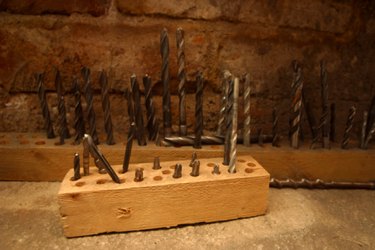
Not all drills are the same. Two popular drill types, a spotting drill bit and a center drill bit, may not appear much different from each other, but the two have very distinct purposes. Though it is possible to use a center drill where a spotting, or spot, drill could be used, and vice versa, it is not recommended.
Center Drill
Video of the Day
A center drill is a shorter, thicker drill with a tapered, or cone shaped end that is much thinner than the shaft of the drill. This end of the drill is used to create a starting point for another drill. The center drill can also drill an indentation so that a screw will lay flush with the surface. A center drill also does not catch or grab the surface being drilled. A center drill is also referred to as a combined drill or a countersink.
Video of the Day
Center Drill Uses
The center drill is made of a high carbide material and is used for metal working. A center drill is used for making a starter hole in cast iron, aluminum, copper, steels, and many other alloys. The center drill is good for metals because the drill does not easily move off target when pressed against the metal. It is shorter and sturdier than some other bits that may bend under pressure or slide away from the point to be drilled. A dull drill bit will not cut as nicely and can also make holes that are not accurate. It is important to use a sharp center drill when performing these tasks.
Spot Drill
A spot drill does much the same as a center drill, but there are two differences. One is that the spot drill is thinner and does not have the conical ends that the center drill does. The second difference is it's accuracy. The spot drill tends to be more precise in drilling a starting point. The reason is that the spotting bit does not have grooves, or spirals, that do not go all the way up the bit shaft. This gives the bit more sturdiness and is less likely to wobble.
Why a Spot Drill?
A center drill is a good choice on more dense metals, but it would not be practical for a softer metal. A spot drill can do the job just as efficiently. Spot drills can also be used for plastics and wood products. Tight areas are benefited by the use of a spot drill. This bit can effectively make a hole without splitting or breaking the material.The spot drill will also increase the accuracy of the secondary drill, or the drill that is to be used afterward on the same hole.